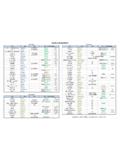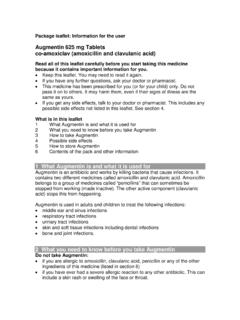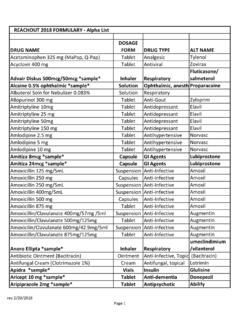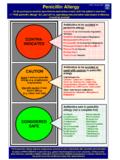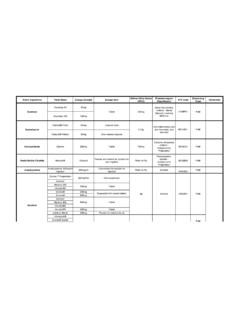Transcription of NEW ZEALAND DATA SHEET - Medsafe
1 1 NEW ZEALAND data SHEET 1. PRODUCT NAME AUG MENT IN 600 mg and g powder for injection 2. QUALITATIVE AND QUANTITATIVE COMPOSITION AUG MENT IN 6 0 0 mg: Each vial contains amoxicillin sodium equivalent to 500 mg of amoxicillin and potassium clavulanate equivalent to 100 mg of clavulanic acid. AUG MENT IN 1 . 2 g: Each vial contains amoxicillin sodium equivalent to 1 g of amoxicillin and potassium clavulanate equivalent to 200 mg of clavulanic acid. For the full list of excipients, see section List of excipients. 3. PHARMACEUTICAL FORM Powder for injection. For reconstitution as an intravenous ( IV) injection or infusion. Vials containing a sterile white to off-white powder. 4. CLINICAL PARTICULARS The rapeutic indications augmentin should be used in accordance with local official antibiotic-prescribing guidelines and local susceptibility data . augmentin is indicated for the short term treatment of common bacterial infections in adults and children such as: Uppe r Respiratory Tract Infections (including ENT): tonsillitis, sinusitis, otitis media Lower Respiratory Tract Infections: acute exacerbations of chronic bronchitis, lobar and broncho-pneumonia Genito-urinary Tract Infections: cystitis, urethritis, pyelonephritis, female genital infections Skin and Soft Tissue Infections Bone and Joint Infections: osteomyelitis Othe r Infections: septic abortion, puerperal sepsis, intra-abdominal sepsis, septicaemia, peritonitis, post-surgical infections augmentin is indicated for prophylaxis against infection which may be associated with major surgical procedures such as gastro-intestinal, pelvic, head and neck, cardiac, renal, joint replacement and biliary tract surgery.
2 2 Susceptibility to augmentin will vary with geography and time. Local susceptibility data should be consulted where available, and microbiological sampling and susceptibility testing performed where necessary. Infections caused by amoxicillin susceptible organisms are amenable to augmentin treatment due to its amoxicillin content. Mixed infections caused by amoxicillin susceptible organism in conjunction with augmentin -susceptible beta-lactamase-producing organisms may therefore be treated by augmentin . Dose and me thod of administration Dose Adults and Children 40 kg and over: Usually g 8 hourly. In more serious infections, increase frequency to 6 hourly intervals. Children 3 months - 12 years: Usually 30 mg/kg* augmentin 8 hourly. In more serious infections, increase frequency to 6 hourly intervals. Children 0-3 months: 30 mg/kg* augmentin every 12 hours in infants < 4 kg and 30 mg/kg* augmentin every 8 hours in infants >4 kg *Each 30 mg augmentin provides 5 mg clavulanic acid with 25 mg amoxicillin.
3 Dosage for surgical prophylaxis: Surgical prophylaxis with augmentin should aim to protect the patient for the period of risk of infection. Accordingly, procedures in adults lasting for less than 1 hour are successfully covered by g AUG MENT IN Intravenous given at induction of anaesthesia. Longer operations require subsequent doses of g augmentin IV (up to 4 doses in 24 hours), and this regime can be continued for several days if the procedure has significantly increased the risk of infection. Clear clinical signs of infection at operation will require a normal course of IV or oral augmentin therapy post-operatively. Special populations Elderly No adjustment needed, dose as for adults. If there is evidence of renal impairment, dose should be adjusted as for renally impaired adults (see below). Renal impairment Adults: Dosing adjustments are based on the maximum recommended level of amoxicillin. Mild Impairment (creatinine clearance >30 mL/min) Moderate Impairment (creatinine clearance 10-30 mL/min) Severe Impairment (creatinine clearance <10 mL/min) Intravenous No change in dosage g IV stat followed by 600 mg IV 12 hourly g IV stat followed by 600 mg IV 24 hourly.
4 Dialysis decreases serum concentrations of augmentin . An additional 3 600 mg IV dose may need to be supplemented at the end of dialysis Each g vial of augmentin contains mmoL of potassium and mmoL of sodium (approx.). Children: Dosing adjustments are based on the maximum recommended level of amoxicillin. Mild Impairment (creatinine clearance >30 mL/min) Moderate Impairment (creatinine clearance 10-30 mL/min) Severe Impairment (creatinine clearance <10 mL/min) Intravenous No change in dosage 30 mg/kg 12 hourly 30 mg/kg every 24 hours Dialysis decreases serum concentrations of augmentin . An additional 15 mg/kg may need to be supplemented at the end of dialysis, then 30 mg/kg/day Hepatic impairment Dose with caution; monitor hepatic function at regular intervals for both adults and children. There are as yet insufficient data on which to base a dosage recommendation. Method of administration augmentin may be administered either by intravenous injection or by intermittent infusion.
5 It is not suitable for intramuscular administration. IV injection: augmentin should be given by slow intravenous injection over a period of 3-4 minutes and within 20 minutes of reconstitution. It may be injected directly into the vein or via a drip tube. IV infusion: Infuse AUG MENT IN over 30-40 minutes and complete within the times stated. For instructions on reconstitution of the medicine before administration, see section Special precautions for disposal and other handling. Contraindications In patients with a history of hypersensitivity to beta-lactams, penicillins and cephalosporins. 4 augmentin is contraindicated in patients with a previous history of augmentin -associated jaundice/hepatic dysfunction. Special warnings and precautions for use Before initiating therapy with augmentin , careful enquiry should be made concerning previous hypersensitivity reactions to penicillins, cephalosporins, or other allergens. Serious and occasionally fatal hypersensitivity reactions (including anaphylactoid and severe cutaneous adverse reactions) have been reported in patients on penicillin therapy.
6 These reactions are more likely to occur in individuals with a history of penicillin hypersensitivity. If an allergic reaction occurs, augmentin therapy should be discontinued and appropriate alternative therapy instituted. Serious anaphylactic reactions require immediate emergency treatment with adrenaline. Oxygen, intravenous steroids and airway management, including intubation may also be required. augmentin should be avoided if infectious mononucleosis is suspected since the occurrence of a morbilliform rash has been associated with this condition following the use of amoxicillin. Prolonged use may also occasionally result in overgrowth of non-susceptible organisms. Pseudomembranous colitis has been reported with the use of antibiotics and may range in severity from mild to life-threatening. Therefore, it is important to consider its diagnosis in patients who develop diarrhoea during or after antibiotic use. If prolonged or significant diarrhoea occurs or the patient experiences abdominal cramps, treatment should be discontinued immediately and the patient investigated further.
7 In general augmentin is well tolerated and possesses the characteristic low toxicity of the penicillin group of antibiotics. Periodic assessment of organ system functions, including renal, hepatic and haematopoietic function is advisable during prolonged therapy. Abnormal prolongation of prothrombin time (increased INR) has been reported rarely in patients receiving amoxicillin-clavulanate and oral anticoagulants. Appropriate monitoring should be undertaken when anticoagulants are prescribed concurrently. Adjustments in the dose of oral anticoagulants may be necessary to maintain the desired level of anticoagulation. augmentin should be used with caution in patients with evidence of hepatic dysfunction. Hepatic events have been reported predominantly in males and elderly patients and may be associated with prolonged treatment. These events have been very rarely reported in children. Signs and symptoms usually occur during or shortly after treatment but in some cases may not become apparent until several weeks after treatment has ceased.
8 These are usually reversible. Hepatic events may be severe and in extremely rare circumstances, deaths have been reported. These have almost always occurred in 5 patients with serious underlying disease or taking concomitant medications known to have the potential for hepatic effects. In patients with renal impairment, dosage should be adjusted according to the degree of impairment (see section Dose and method of administration). Convulsions may occur in patients with impaired renal function or in those receiving high doses. The occurrence at treatment initiation of a feverish generalised erythema associated with pustule may be a symptom of acute generalised exanthemous pustulosis (AEGP). This reaction requires augmentin discontinuation and is a contraindication to subsequent administration of amoxicillin. The presence of clavulanic acid in augmentin may cause a non-specific binding of IgG and albumin by red cell membranes leading to a false positive Coombs test.
9 If the parenteral administration of high doses is necessary, the sodium content must be taken into account in patients on a sodium restricted diet. In patients with reduced urine output crystalluria has been observed very rarely, predominantly with parenteral therapy. During administration of high doses of amoxicillin it is advisable to maintain adequate fluid intake and urinary output in order to reduce the possibility of amoxicillin crystalluria (see section Overdose). Interaction with other medicines and other forms of interaction Concomitant use of probenecid is not recommended. Probenecid decreases the renal tubular secretion of amoxicillin. Concomitant use with augmentin may result in increased and prolonged blood levels of amoxicillin, but not of clavulanic acid. Concomitant use of allopurinol during treatment with amoxicillin can increase the likelihood of allergic skin reactions. There are no data on the concomitant use of augmentin and allopurinol.
10 In common with other antibiotics, augmentin may affect the gut flora, leading to lower oestrogen reabsorption and reduced efficacy of combined oral contraceptives. In the literature there are rare cases of increased international normalised ratio in patients maintained on acenocoumarol or warfarin and prescribed a course of amoxicillin. If co-administration is necessary, the prothrombin time or international normalised ratio should be carefully monitored with the addition or withdrawal of amoxicillin. The presence of clavulanic acid in augmentin may cause a non-specific binding of IgG and albumin by red cell membranes leading to a false positive Coombs test. In patients receiving mycophenolate mofetil, reduction in pre-dose concentration of the active metabolite mycophenolic acid of approximately 50% has been reported following commencement of oral amoxicillin plus clavulanic acid. The change in pre-dose level may not accurately represent changes in overall MPA exposure.











